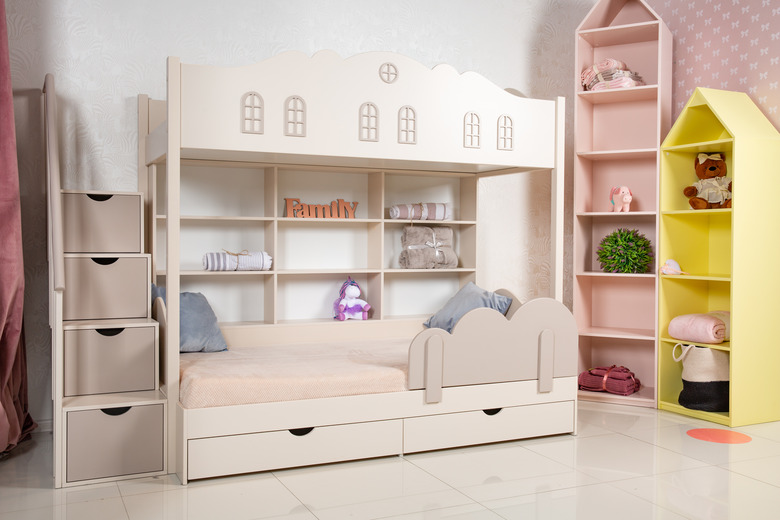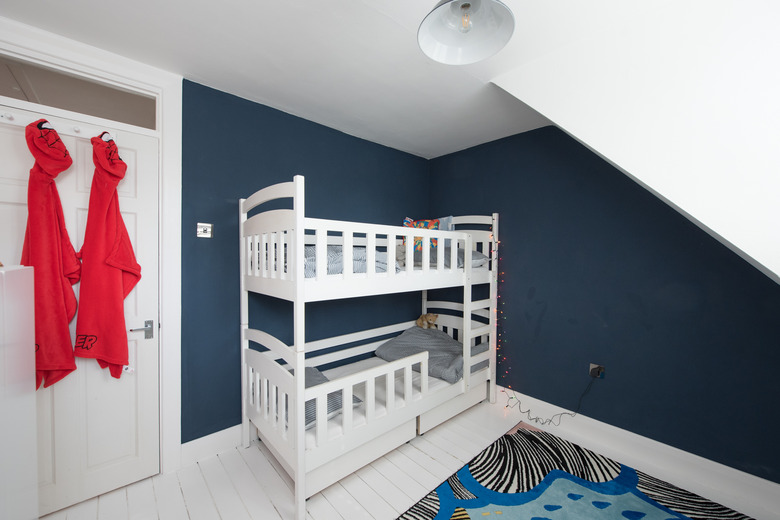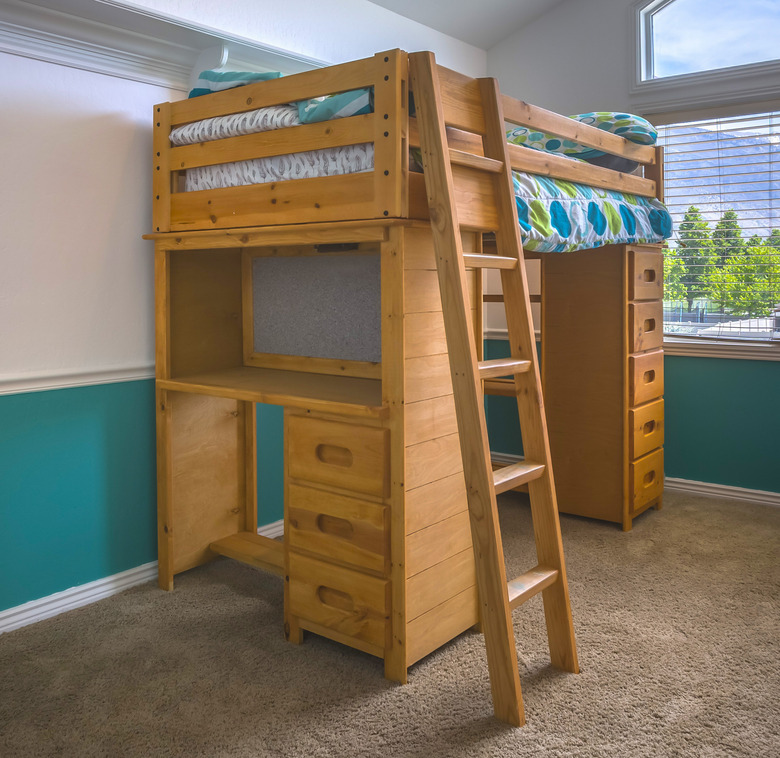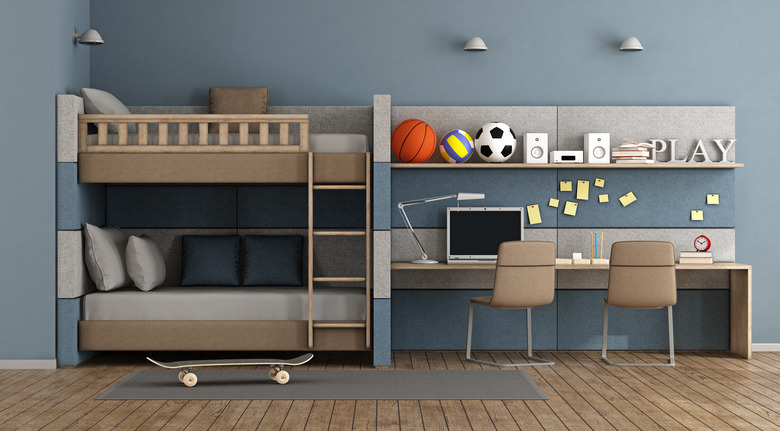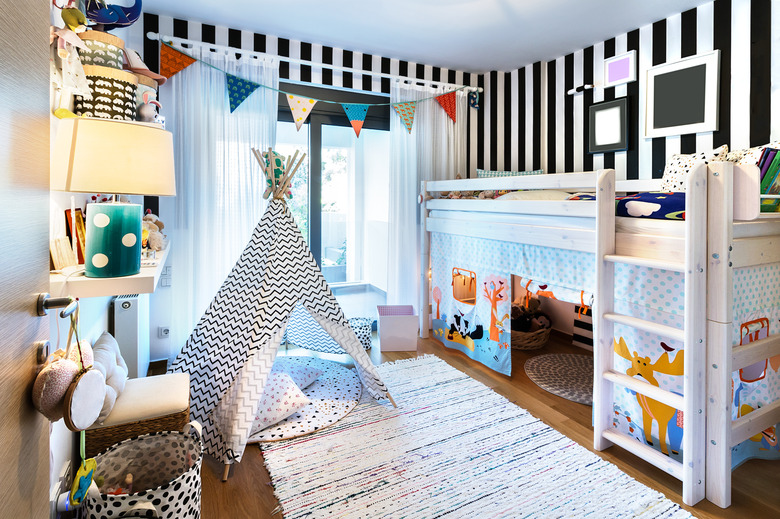Keeping Bunk Beds Safe For Your Kids
While it's common sense that bunk beds should be safe before use, approximately 36,000 bunk-related injuries happen to children every year in the United States, according to Nationwide Children's Hospital. Most such injuries are from falls while sleeping or playing, which means they probably could have been prevented if safety precautions had been followed. Optimal safety involves not only ensuring that the bed is structurally sound and free from hazards, but that children are instructed on proper bunk use. In other words, jumping on the top bunk is not a good idea, nor should several kids hang out on the top bunk at the same time.
Before You Buy
Before You Buy
Any new loft or bunk bed should meet current safety regulations, set in place in 2000 by the Consumer Product Safety Commission. The product information should clearly list the manufacturer, as well as a certificate ensuring the bed has been tested and meets safety standards. An older secondhand bunk bed, or even a DIY version, may not meet these standards, so it may require a bit of modification to ensure utmost safety.
Guardrail and Ladder Guidelines
Guardrail and Ladder Guidelines
Aside from proper assembly, the guardrails and ladder or steps leading to the top bunk are among the most important safeguards on the bed. Standards in the United States require that the top bunk area on a bunk bed or loft bed has guardrails on both sides of the bunk. These rails should be at least 5 inches higher than the top of the mattress, and with gaps no larger than 3.5 inches between rails. The height helps prevent children from rolling off the bed, while the small gaps ensure a child can't get his head trapped between railings.
The 5 inches above the mattress rule also applies to the head and foot sections of the top bunk. In this case, however, the railing or headboard and footboard must cover only half of the exposed width of the bed. The side guardrails must span the entire length of the bed, other than the access port above the ladder. This access point must be 15 inches or narrower.
The ladder or steps used to access the top bunk should also be secure and unable to slip, wobble or otherwise come free from the bed during use.
Building and Assembling Checklist
Building and Assembling Checklist
Whether building a bed from plans or assembling a bed from a big-box store, proper assembly is the key to preventing bed failure and helping prevent injuries. While a slight wobble may not be much of an issue for the typical bed, it could be a big deal on a bunk bed, causing screws to loosen to the point that the frame pieces separate. The extra time and care spent during assembly help guarantee the bunks are as safe as possible before use.
- Wooden elements should be smooth, with no splintering boards or sharp corners. Check every portion of each board to ensure it's safe. If necessary, sand problem areas smooth to help prevent injuries. Metal parts should also be free from burrs and sharp edges.
- Fasteners such as screws or bolts should not stick out from the bed, whether the bed is made of wood or metal. Protrusions could cause cuts and scrapes, or even snag clothing.
- Follow assembly instructions, even if the project seems simple. Make sure all parts are used with none left over (unless the package intentionally includes spare fasteners). An unintentionally left-over part could be cause for a major safety concern over time.
- Wiggle the assembled bed from various angles before pushing it against the wall. If the bed wobbles, tighten fasteners and make sure all bracing elements are in place.
- Apply weight and pressure to the mattress foundation for both top and bottom bunks. These should offer enough support so that they won't fail under the weight of children using the beds. This foundation area should fully support the entire mattress evenly—no slat-based systems with huge gaps that allow the mattress to sag between boards.
- Check the mattress foundation area for gaps near the frame before adding the mattress. A safe bunk bed has no gaps between the foundation and framework large enough for a child's head to get trapped. Inspect the bed again once the mattresses are in place.
- Use only the mattress size indicated for the bunks. For instance, a twin mattress is shorter than a twin XL and should not be used on a twin XL bunk.
The Importance of Placement
The Importance of Placement
No matter the age of the kids sharing the room, bunk bed placement is a key safety concern. Place the structure in a corner, whenever possible, to add stability. This helps keep the bed from wobbling as a child accesses the top bunk. The less the bed wobbles, the less frequently you'll have to tighten its screws or nuts.
- Keep the bed a safe distance from ceiling fans, light fixtures and curtain hardware to ensure the child in the top bunk doesn't hit her head while in bed or climbing the ladder. The bed should also be away from windows.
- Remove obstructions and tripping hazards from the ladder or top-bunk access point area, as well as from the walking path from the bunks to the bedroom door. Remind the kids to pick up toys and clothing before going to bed each night to keep their path to bed clear.
- No items such as clothing, ropes or toys should be hung from the top bunk's posts or the ladder area. These could cause injury or strangulation.
- Place a nightlight in an outlet near the ladder, illuminating the climbing area. If the room is extremely dark at night, add another light so that the path to the room's exit is visible in the middle of the night.
Rules for the Kids
Rules for the Kids
Whether the kids are in elementary school or home from college, periodically review a few basic rules with them to help ensure their safety while using the bunks.
- Children under age six shouldn't sleep in the top bunk. They don't have the coordination necessary to climb the ladder safely, especially in dark conditions.
- Only one child should use the top bunk at a time. This is especially true for teens and tweens, as the added weight could cause the mattress foundation to fail.
- No rough playing or jumping on either bunk. This also means no climbing on or hanging from the framework.
- While it's tempting to hang backpacks, clothing or other items from the bedposts or the ladder, don't. These are all potential safety issues.
- The area surrounding the bed should be kept free of clutter. Get the kids into the habit of removing potential tripping hazards such as clothing and shoes from the area surrounding the bunk. The kids should do this on a daily basis, before going to bed.
- For sleepovers, remind all guests of these rules to help prevent injuries.
